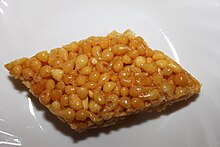Boondi is an Indian snack made from fried chickpea flour. It is either eaten as a savory snack or sweetened as a dessert.[1]
 Boondi Mithai | |
| Alternative names | Buniya, Bonde, Bundi, Badana |
|---|---|
| Course | Dessert |
| Place of origin | Indian subcontinent |
| Region or state | Odisha, Rajasthan, Punjab , Karnataka, Gujarat, Maharashtra, Haryana, Andhra Pradesh, West Bengal, Uttar Pradesh, Bihar |
| Main ingredients | Gram flour, Sugar |
| Variations | Khara or Kara |
In Sindh and Rajasthan, the dish is called nukti (Sindhi: نڪتي, Dhatki: نڪتي | नुक्ती). In Nepali, it is referred to as buniya (बुनिया). In Bihar, it is called bundiya (बुंदिया).
Preparation edit
To make the crispy savory snack, chickpea flour, baking powder, and turmeric are mixed into a batter. A slotted spoon is used to pour small drops into a deep frying pan. The boondi is then soaked in sugar syrup.[2][3] Crushed curry leaves are added. Khara boondi (savory boondi) is eaten by itself or is added to Indian-mixture.
Variations edit
Boondi is popularly used to prepare raita in North India. Boondi raita typically contains curd (plain yoghurt), boondi (which has been soaked in water to make it soft, then sieved) and seasonings of salt, chilli, and other spices. It is eaten as a side dish with pulao or any other meal.[1]
To make boondi laddu, fried boondi is dipped in sugar syrup and compacted into a ball. It can be garnished with nuts and raisins.[3]
References edit
- ^ a b Tiwari, Brijesh; Singh, Narpinder (2015). Pulse Chemistry and Technology. Royal Society of Chemistry. p. 271. ISBN 9781782625674.
- ^ Pandya, Michael (1989). Indian Vegetarian Cooking. Inner Traditions. p. 179. ISBN 9780892813421.
- ^ a b Sudhir, Satya (2018). A Hundred Red Roses. Notion Press. ISBN 9789386295897.
External links edit
- Media related to Boondi at Wikimedia Commons